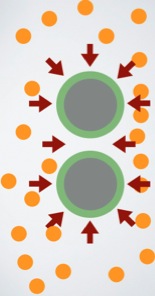Liquid Crystalline Soft Matter
Depletion attraction
This is a very interesting and in some sense somewhat mysterious interaction, sometimes useful, sometimes troublesome, that can occur in colloidal suspensions with more than one species suspended in the continuous phase, where one is substantially smaller than the other. Both species should be well suspended (or even dissolved) in the continuous phase but they should not attract but rather repel each other. The larger suspended species normally constitutes the regular disperse phase, whereas the smaller particles are often referred to as “depletants”. The origin of the phenomenon is the excluded volume that the large disperse phase particles constitute for the depletants due to the repulsion between particles and depletants. If sufficient large particles and sufficient depletants are present in the system (usually the depletants are present at much higher number), then the total volume that is excluded from the Brownian motion paths of the depletants can be substantial, giving rise to a considerable entropy penalty. If the large particles aggregate the total excluded volume for the depletants is reduced and the entropy gain realized in this way is sufficient to drive aggregation of the dispersed phase particles even if they are stabilized by e.g. surfactants. An alternative view of the phenomenon is that the depletants exert an osmotic pressure on the disperse phase particles (this pressure arises as a result of the reduction in concentration of depletants in the volume separating adjacent disperse phase particles) that drives them together, see illustration to the right.
In our research it is important to be aware of depletion attraction and its consequences. In some cases, such as in suspensions of nanoparticles that should be well separated, it must be avoided. This that can be quite difficult since the micelles typically formed by the surfactants that are often used for stabilizing nanoparticle suspensions can act as depletants. In a collaboration with the LC Nano Lab of Prof. Giusy Scalia we came up with a way to avoid this phenomenon by preparing nanoparticle suspensions below the surfactant’s Krafft temperature, a work that was published in Angewandte Chemie:
- Utilizing the Krafft phenomenon for achieving ideal micelle-free surfactant-stabilized nanoparticle suspensions
Sarah Dölle, Bob-Dan Lechner, Ji Hyun Park, Stefan Schymura, Jan P. F. Lagerwall and Giusy Scalia
Angewandte Chemie - Int. Ed., 51, pp. 3254-3257 (2012)
- Entropy driven self-assembly of nonamphiphilic colloidal membranes
Edward Barry and Zvonimir Dogic
PNAS, 107, 23, pp. 10348-10353 (2010) - Lock and key colloids
S. Sacanna, W. T. M. Irvine, P. M. Chaikin, D. J. Pine
Nature., 464, 7288, pp. 575-578 (2010)
 Back to research overview map.
Back to research overview map.
